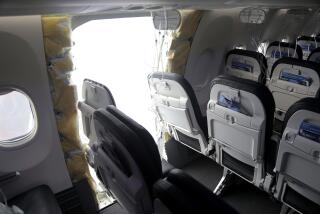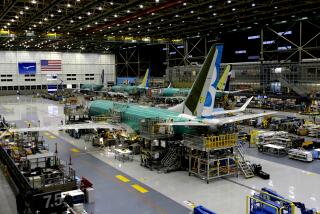British Begin Inquiry Into 737 Explosion
- Share via
LONDON — British air safety investigators began piecing together evidence Friday that they hope will pinpoint the cause of an explosion and fire that ripped through a Boeing 737 airliner at the northern English city of Manchester on Thursday, taking 54 lives.
The investigation centered on one of the plane’s two U.S.-made Pratt & Whitney jet engines. Experts involved in the investigation believe that the engine exploded as the plane reached takeoff speed, hurling fragments into fuel lines and fuel tanks in the wings.
On board the plane--owned by British Airtours, a subsidiary of British Airways--were 131 British vacationers and a crew of six. They were on the way to the Greek island of Corfu.
Inspection Recommendation
Controversy cropped up in the investigation with word that a U.S. government agency recommended last month that the Pratt & Whitney JT8D, the same engine that the Airtours Boeing was equipped with, be carefully inspected because of a series of failures on ascent after takeoff.
Officials of Britain’s Civil Aviation Authority, the body responsible for air safety, and British Airways both say they were aware of an October, 1984, directive ordering U.S. carriers to begin inspecting a low-pressure turbine disc for potentially dangerous wear, but both say they knew nothing of last month’s recommendation.
“I can state categorically that we were not notified either by the CAA or Pratt & Whitney of the July action,” British Airways spokesman Norman Lornie said. He added that the airline has now called for an immediate computerized check of technical performance on all JT8D engines in its fleet, but that there has been no discussion of grounding 737s.
British Airways operates 34 of the twin-engine Boeing 737s; British Airtours has 11. All are equipped with the Pratt & Whitney JT8D.
Other Problem Suspected
Despite the controversy, unofficial findings indicated that the problem that led to Thursday’s disaster may involve a different part of the engine.
Civil Aviation Authority spokesman Peter Kennedy said Friday that preliminary findings appear to rule out the turbine disc as the source of the trouble, since it appears that the explosion occurred in the forward part of the engine rather than the rear part, where the disc is situated.
“The second-stage turbine discs are not suspect,” Kennedy said.
Investigators from Pratt & Whitney who arrived Friday in Manchester have also reportedly informed engineers at their East Hartford, Conn., headquarters that no rotating part of the engine appears to have been at fault.
Their findings apparently support an early, tentative assessment made by Pratt & Whitney people Thursday that one of the engine’s nine cylindrical fuel-combustion chambers may have blown off, igniting fuel as it ripped through the plane’s tanks.
Engine Maker’s Statement
Late Friday, Pratt & Whitney’s parent company, United Technologies, issued a statement in Hartford telling operators of Boeing 737 aircraft to inspect all JT8D engines, particularly their combustors.
“We felt it was prudent to reemphasize these recommendations after preliminary reports covering the accident in Manchester,” David Long, a company spokesman said.
A British Airways spokesman said it had no comment on the United Technologies statement.
Officials at the accident investigation branch of Britain’s Department of Transport, which has overall responsibility for the crash inquiry, declined to comment on its possible cause.
“We’re not prepared to speculate at this point,” a spokesman said. “We are looking at every possible aspect of this disaster.”
More to Read
Inside the business of entertainment
The Wide Shot brings you news, analysis and insights on everything from streaming wars to production — and what it all means for the future.
You may occasionally receive promotional content from the Los Angeles Times.










